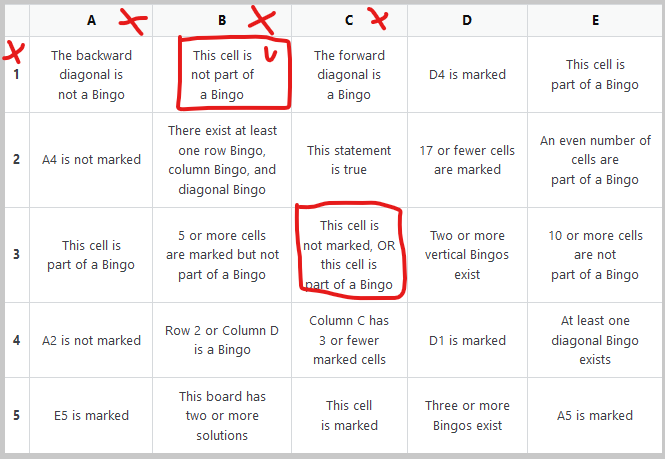Note: Please don't upvote this answer post. Instead, upvote Lolgast's answer post, which has the same final answer as this one but with (a) a more coherent exposition and (b) no mistakes (unlike mine, which had a mistake that Lolgast later fixed).
B1 must be marked, else it's empty but part of a bingo. Then column B is not a bingo. Column A is not, either, since precisely one of A2 and A4 is filled in. The internal logic of C4 implies column C is not a bingo. The internal logic of C3 implies it's part of a bingo.
Consider the case that column D is a bingo. Then D3 is marked, so column E is also a bingo. C3's part of a bingo, so we have 13 squares already part of a bingo. By the statement in D2, the statement in B3 must then be false, so A3 is also unmarked. By the statement in E4, there's at least one diagonal bingo; by the statement in A1, there's at most one. Since we know the statements in A5 and B4 to be true, the backward diagonal is the bingo, and A1 and C1 are unmarked; thus B1 is marked. Since C1 is unmarked, if C4 is also then it's true; so C4 is marked; thus, precisely one of C2 and C5 is marked. By E2 there must be another bingo; the only remaining possible ones are rows, so B2 is marked. So we have a row bingo: which row? We've already eliminated rows 1 and 3. If row 4 or 5 is a bingo, then the other must be also, to satisfy the statement in E2. Otherwise, row 2 is a bingo. Either way, B5 is true. 
Otherwise, column D is not a bingo. We already know B5 is true, since column D could be a bingo. And D3 is false. A3 is unmarked because D3 is. Now consider the statement in B4. If it's true, then row 2 is a bingo, so B2 is marked, as is D5, and column E is a bingo. E5 implies A5 is marked, completing the backward diagonal bingo, so A1 is unmarked, and thus C1 is too. If B3 is marked, then B1 can't be, but then it must be marked; so B3 is unmarked. B2 is then not part of any bingo, so is marked. If C4 is unmarked, it's true, so it must be marked. Then C5 cannot be, which will yield four marked cells not part of a bingo; because B3 is unmarked, then, D1 and D4 cannot be. 
That was assuming B4 is true; otherwise, it's false and row 2 is not a bingo. Then A1 is true. If B2 is true, there's a column bingo, which must be column E, and E2 then implies row 2 is a bingo. The statement in D2 will then prevent any further markings and C4 will be a contradiction. So B2 is false, C1, E4 and D5 are false, and there's no bingo at all, contradicting C3. So B4 must be true.
and C4 will be a contradiction. So B2 is false, C1, E4 and D5 are false, and there's no bingo at all, contradicting C3. So B4 must be true.
Edit, thanks to Lolgast:
In the case column D is a bingo, we wind up with >17 marked cells, violating D2. Therefore, column D is not a bingo, and B4 is true (as noted above), and B5 is false.










